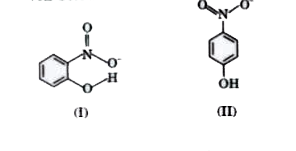Statement-1: In all hydrogen halide compound HF is the only liquid acid.
Statement-2: HF shows intramolecular H-bonding in between two HF molecules.
Statement-I is True, Statement-II is True : Statement-II is a correct explanation for Statement-I
Statement-I is True, Statement-II is True : Statement-II is NOT a correct explanation for Statement-I
Statement-I is True, Statement-II is False.
Statement-I is False, Statement-II is True.
To solve the problem, we need to analyze both statements provided in the question.
Step 1: Analyze Statement-1
Statement-1: In all hydrogen halide compounds, HF is the only liquid acid.
- Explanation: Hydrogen halides include HF (hydrogen fluoride), HCl (hydrogen chloride), HBr (hydrogen bromide), and HI (hydrogen iodide). Among these, HF is unique because it can exist as a liquid at room temperature and pressure. The other hydrogen halides are gases at room temperature. Therefore, Statement-1 is true.
Step 2: Analyze Statement-2
Statement-2: HF shows intramolecular H-bonding in between two HF molecules.
- Explanation: Hydrogen fluoride (HF) does exhibit hydrogen bonding, but it is primarily intermolecular hydrogen bonding, which occurs between different HF molecules. Intramolecular hydrogen bonding would imply that the hydrogen bond is formed within the same molecule. In HF, the hydrogen bonding occurs between separate HF molecules, not within a single molecule. Therefore, Statement-2 is false.
Conclusion
- Statement-1 is true.
- Statement-2 is false.
Thus, the correct answer is that Statement-1 is true and Statement-2 is false.
Final Answer
- Statement-1: True
- Statement-2: False
Statement-1: In all hydrogen halide compounds, HF is the only liquid acid.
Statement-2: HF shows intramolecular H-bonding in between two HF molecules.
- Statement-1 is true.
- Statement-2 is false.
- Statement-1: True
- Statement-2: False
Topper's Solved these Questions
- TEST PAPERSBOOK - BANSALCHAPTER - TEST PAPERSEXERCISE - CHEMISTRY PART (A)
14 Videos
- TEST PAPERSBOOK - BANSALCHAPTER - TEST PAPERSEXERCISE - CHEMISTRY PART (B)
1 Videos
- TEST PAPERSBOOK - BANSALCHAPTER - TEST PAPERSEXERCISE - Chemistry PART D
4 Videos
- SOLUTIONSBOOK - BANSALCHAPTER - SOLUTIONSEXERCISE - Exercise4
32 Videos
- THERMOCHEMISTRYBOOK - BANSALCHAPTER - THERMOCHEMISTRYEXERCISE - Exercise 4
15 Videos
Similar Questions
Knowledge Check
Statement-1:PhCOCOCOPh forms stable hydrate
Statement-2:The compound in the hydrate form has intramolecular H-bonding.AStatement-1 is True, Statement-2 is True, Statement-2 is a correct explanation for Statement-1BStatement-1 is True, Statement-2 is True, Statement-2 is NOT a correct explanation for Statement-1CStatement-1 is True, Statement-2 is False.DStatement-1 is False, Statement-2 is True.To explain the abnormality in some molecules , the conecpt of H-bonding was introduced , Hydrogen bonding is defined as the phenomenon in which H-bonding beteen two molecules is called intermolecular H-bonding between two molecules is called intermolecular H-bonding .Hbonding within a molecule is called intramolecular H-bonding or within a molecule is called intramolecular H-bonding or chelation .Intermolecular H-bonding favoure for cluster formation whereas intramolecular H-bnding prevents the cluster formation
HF−2 exists in solid state and in liquid HF but bot in aqueous solution because :AHF−+2H2O→H3O++2F−BHF+H2O→H−2F++OH−CHF−+2H2O→H2F2+OH−Dnone of theseTo explain the abnormality in some molecules , the conecpt of H-bonding was introduced , Hydrogen bonding is defined as the phenomenon in which H-bonding beteen two molecules is called intermolecular H-bonding between two molecules is called intermolecular H-bonding .Hbonding within a molecule is called intramolecular H-bonding or within a molecule is called intramolecular H-bonding or chelation .Intermolecular H-bonding favoure for cluster formation whereas intramolecular H-bnding prevents the cluster formation
Which molecule does not show intramolecular H-bonding ?ASalicylakdehydeBChloralhydrateCEthanolDNickel dimethyl glyoximate
Structures of molecules of two compounds are given below :

(a) Which of the following compounds will have intermolecular hydrogen bonding and which compound is expected to show intramolecular hydrogen bonding?
(b) Which of the above two compounds will show higher melting point?
(c ) Which of the above compounds will form hydrogen bond with water easily and be more soluble in it?
View SolutionTo explain the abnormality in some molecules , the conecpt of H-bonding was introduced , Hydrogen bonding is defined as the phenomenon in which H-bonding beteen two molecules is called intermolecular H-bonding between two molecules is called intermolecular H-bonding .Hbonding within a molecule is called intramolecular H-bonding or within a molecule is called intramolecular H-bonding or chelation .Intermolecular H-bonding favoure for cluster formation whereas intramolecular H-bnding prevents the cluster formation
Which of the following statement is wrong ?
View SolutionTo explain the abnormality in some molecules , the conecpt of H-bonding was introduced , Hydrogen bonding is defined as the phenomenon in which H-bonding beteen two molecules is called intermolecular H-bonding between two molecules is called intermolecular H-bonding .Hbonding within a molecule is called intramolecular H-bonding or within a molecule is called intramolecular H-bonding or chelation .Intermolecular H-bonding favoure for cluster formation whereas intramolecular H-bnding prevents the cluster formation
Which statement is wrong ?
View SolutionTo explain the abnormality in some molecules , the conecpt of H-bonding was introduced , Hydrogen bonding is defined as the phenomenon in which H-bonding beteen two molecules is called intermolecular H-bonding between two molecules is called intermolecular H-bonding .Hbonding within a molecule is called intramolecular H-bonding or within a molecule is called intramolecular H-bonding or chelation .Intermolecular H-bonding favoure for cluster formation whereas intramolecular H-bnding prevents the cluster formation
The correct repesentation of H-bonding beteen NH3 and H2O is :
View SolutionStatement-1 : Boiling point of H2O is more than HF .
and
Statement-2 : Intermolecular hydrogen bonding in HF is stronger than H2O.
View Solution
